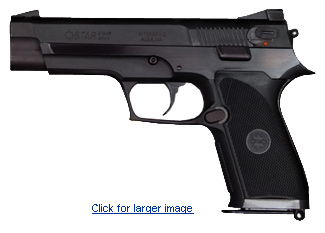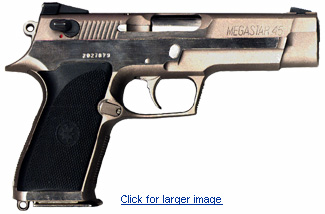Star Firearms — The Megastars
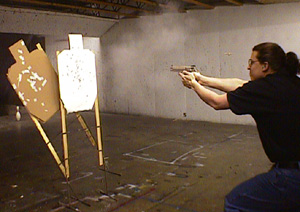
The Megastar is a large, all-steel, selective double-action, double-column automatic pistol, designed specifically to accept both .45 ACP and 10 mm Norma Auto cartridges. The Megastar is also known as the Model 50, but it was sold almost entirely under the Megastar brand name throughtout the world. The slide is, in my experience, invariably marked "Megastar" plus the caliber in large letters on the right side.
Manuals & Disassembly Instructions
I do not have manuals for every pistol shown on this site. However, in many cases there is a related manual. Partly to make the series relationships clearer, and partly to assist with speed and accuracy of updating, all manuals can be found in one place, the manuals page. All manuals available are provided as downloadable PDFs, or you may purchase a printed copy of the entire set of handgun manuals.
There is a low-resolution (but still usable) copy of the Megastar manual now available for free download. Note it is somewhat different than other modern series pistols, so pay attention to the detail stripping instructions.
Megastars are are perfect examples of the modern Star style, taking all design and style cues from the M28/31/31 series. They have inverted slide rails, closed-cam unlocking, a slide mounted safety, removable double-action lockwork and so on. See the 28, 30 and 31 page for notes on the evolution of these features, and more details. Like the Model 31, the safety lever also acts as a decocker when pressed down past safe. Releasing it will return the lever to safe; releasing it very smartly will return it to the fire position.
Both blue (actually black phosphate) and Starvel nickel plated versions were available, in both calibers. Magazines held 12 rounds of .45 and 14 of 10 mm. For no clear reason, most 10 mm magazines in the US have a strip of steel welded to the inside to limit their capacity to 12 rounds also. The .45 magazines will function correctly, however, and hold the full 14 rounds. Magazines are also available in either Starvel or black phosphate, though are relatively rare, and hence expensive.
There are no other variants. No compact, target, or upgraded versions of any sort that I am aware of. All came with the same nice but fixed sights. If you can handle the grip size, the weight makes it a very easy gun to shoot even with very powerful loads. Note that I have experienced severe leading with the .45 versions, so either clean carefully, or avoid solid lead bullets. The gun is built like a tank, so I did not have any severe failures, however.
Why a big 10 mm?
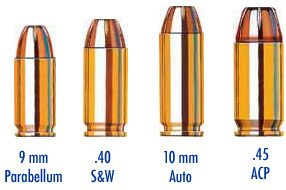
The Bren Ten pistol and the accompanying cartridge was introduced in 1983, as a collaboration between Dornaus & Dixon and Norma. The idea originated somewhat earlier, with Jeff Cooper postulating a .400 caliber cartridge with better than 9 mm terminal performance and better than .45 ballistic performance. The gun and cartridge languished as a niche, sort of automatic magnum for some years, till the FBI began using them for special purposes in the late 1980s.
An investigation of the 1983 Miami shootout (which killed two FBI agents and wounded five others) resulted in the bureau finally dropping the .38 Special revolver in favor of an automatic. The choice suprised everyone by being a 10 mm automatic (the S&W 1076).
At the time of its introduction in 1992, the Megastar was the only production pistol rated for a steady diet of full-power 10 mm ammunition. Colt Delta Elite 1911s and the Smith & Wesson 10xx pistols would shoot themselves apart under such stress. The FBI's downloaded 10 became the .40 S&W, and smaller pistols again were all the rage. The 10 mm Norma Auto never caught on, and the FBI moved on to .40 caliber SIGs.
By the time the Megastar was in full production, it was almost too late. Star sorta missed the boat here. However, I have to wonder what they were thinking with this gun in general. If it was to be a defensive pistol, I would expect compact and alloy framed versions. Star certainly knew how to do this, and had achieved their best commercial success with small, light versions of their larger guns, and then the Firestar line. Additionally, why was there never a 10 mm Firestar? The lanyard loop is another thing that makes me wonder. Only duty pistols for certain police forces, and most armies really need a lanyard loop. By the 1990s it was simply never seen on a commercial market pistol. I wonder if there was not some specific contract that Star was pursuing with the Megastar, which they presumably didn't get. Not wanting to waste the engineering dollars, the gun entered production as a commercial product. This is all speculation; I don't have the answers, but the clues are tantalizing.
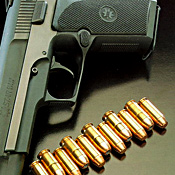
|
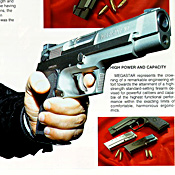
|
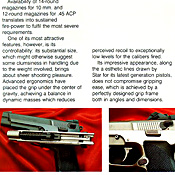
|
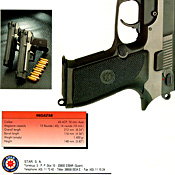
|
Images from a contemporary brochure on the Megastar.
